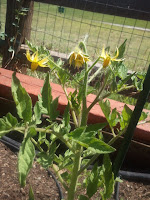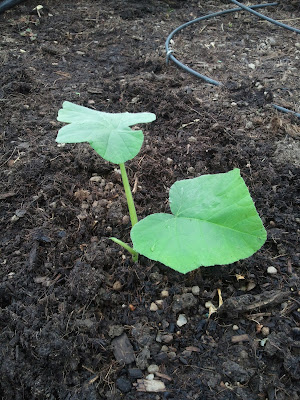Or at least that's the hope! My man and I went to the Flower Bin here in Longmont a couple weeks ago in search of both veggies to harvest in the fall and for something that would hopefully deter birds from my garden.
As I've written before, birds were eating my lettuce seedlings, making me think I needed to grow them a little larger and transplant them into the garden. But first I wanted to see if I could find something to deter them from eating them in the first place.
We found just one thing that was shiny (I have read in many places online that hanging CDs from a tree nearby, etc helps) and that I actually wanted in my garden: a Drunken Dragonfly made by Paul's Metal Petals.
It's made of silverware (cool, right?) and seems to be reflective enough to keep birds away. I only have anecdotal evidence, but the seeds I planted the same day that I put the garden ornament in the ground have turned into seedlings and have not yet been eaten by birds.
Check it out:
Sunday, July 28, 2013
Monday, July 22, 2013
What Can I Do with All These Cucumbers?!?
My cucumbers are thriving in my garden this year! I think I've said this before, but I attribute that to giving them plenty of space and having a nice trellis for them to climb (and already overtake!).
But I'm harvesting a couple cucumbers a day, and I'm not seeing an end to that. So what in the world will I do with them, aside from sharing with my co-workers? Zucchini is easier - lots of options to mix zucchini in with any number of dishes. (Here are a few of my favorite zucchini recipes ...)
One of the great benefits of gardening is that you suddenly have a bunch of produce, and you have to come up with creative ways to use it! It's great motivation because you certainly don't want to throw it out and while I don't mind sharing produce, I would like to use as much of it as possible at my own house (until we get sick of it!).
So I'm on a mission to find some new cucumber recipes to try. I'm going to link to them here, and then try them out over the next week or two. Then I'll let you know how they went!
Here are three cucumber recipes that go beyond just throwing them in a salad (which I will also do). These are all from allrecipes.com, one of my favorite places to find good recipes, mostly because the review system is excellent! I often learn more from the reviewers than from the people submitting the recipes.
 |
| Exhibit 1: Discovered this cucumber, hidden and overgrown, the other day. Here it is next to a couple of perfectly sized zucchinis! |
One of the great benefits of gardening is that you suddenly have a bunch of produce, and you have to come up with creative ways to use it! It's great motivation because you certainly don't want to throw it out and while I don't mind sharing produce, I would like to use as much of it as possible at my own house (until we get sick of it!).
So I'm on a mission to find some new cucumber recipes to try. I'm going to link to them here, and then try them out over the next week or two. Then I'll let you know how they went!
Here are three cucumber recipes that go beyond just throwing them in a salad (which I will also do). These are all from allrecipes.com, one of my favorite places to find good recipes, mostly because the review system is excellent! I often learn more from the reviewers than from the people submitting the recipes.
Sunday, July 21, 2013
Rediscovering Beauty in the Front Yard
One of the fringe benefits of cleaning up a flower garden is rediscovering the beautiful flowers you actually have. We inherited the landscaping in the front of our home last year when we moved in, and the flowers are set such that something is always blooming! It's the best way to do it. Different flowers bloom at different times of year, no matter where you're at, and I've really enjoyed learning about the ways of the non-edible gardening world.
Yesterday I did a long overdue cleanup, trimming bushes and getting rid of flowers that bloomed weeks ago that have since dried up.
I don't pay that area of my front yard a lot of attention during the week, so I was pleased to see some beautiful flowers currently blooming! Here's a taste.
Yesterday I did a long overdue cleanup, trimming bushes and getting rid of flowers that bloomed weeks ago that have since dried up.
I don't pay that area of my front yard a lot of attention during the week, so I was pleased to see some beautiful flowers currently blooming! Here's a taste.
Thursday, July 18, 2013
Inspired By ... Midsummer Planting
I have a gap in my garden right now, and I really want to fill it. Being relatively new to gardening, I wasn't sure what veggies I could plant midsummer for harvest in the fall.
I found this handy chart from the University of Minnesota Extension. The bottom line: I already knew I could do lettuce and kale and cabbage.
I don't have a ton of space, but enough that I can try a few new veggies out for some fresh fall treats, and add to my garlic patch (a small area of my garden) for garlic harvest next year.
I'm thinking I'll try out cauliflower and beets, both of which can handle a little frost in addition to planting more kale and lettuce under my cucumber trellis. (Only a few of my previous lettuce seeds actually are resulting in actual seedlings.)
I found this handy chart from the University of Minnesota Extension. The bottom line: I already knew I could do lettuce and kale and cabbage.
I don't have a ton of space, but enough that I can try a few new veggies out for some fresh fall treats, and add to my garlic patch (a small area of my garden) for garlic harvest next year.
I'm thinking I'll try out cauliflower and beets, both of which can handle a little frost in addition to planting more kale and lettuce under my cucumber trellis. (Only a few of my previous lettuce seeds actually are resulting in actual seedlings.)
Tuesday, July 16, 2013
Why Tomatoes May Flower ... But Not Set Fruit
My co-worker asked me today if I had any idea why her heirloom tomato plant was flowering and had been for a few weeks, but she had not yet seen fruit start to form.
I wasn't sure, but encouraged her to feed the plant if she hadn't (it's growing in a container, which makes it even more important to fertilize) as a starting point.
I did some research tonight on tomatoes and their fruit-setting ways and found two things, both highlighted in this article from Bonnie Plants, but also noted by other authors:
I wasn't sure, but encouraged her to feed the plant if she hadn't (it's growing in a container, which makes it even more important to fertilize) as a starting point.
I did some research tonight on tomatoes and their fruit-setting ways and found two things, both highlighted in this article from Bonnie Plants, but also noted by other authors:
Sunday, July 14, 2013
3 Lessons on Lettuce
I harvested a lot of lettuce this year for our daily lunch salads. But I had much higher hopes for my lettuce harvest.
Recently, I discovered that birds had been eating the lettuce seedlings that were coming up. I caught the problem too late though (thinking the seedlings were just taking their time growing) and while I covered up some of the remaining lettuce with row covers, I think it was too little too late. (You can also put something shiny/reflective near where birds are eating your veggies; some people suggest CDs hanging nearby, but I'm sure there is some garden art somewhere that would serve the same purpose.)
Bird netting would work, as well.
Anyway, I do have some seedlings that are doing OK that I planted later on, but because of a few mistakes I made this year so far, I have learned a couple lessons about growing lettuce:
1. Don't plant too many seedlings too early. Actually, early is fine. But I could have - and should have - staggered my transplants in the garden. This fall, when I plant again, I will stagger the plantings, so that all the lettuce I have doesn't get ripe (and later bolt) at the same time. Now I know how few lettuce plants I actually need to make a salad, since they will keep growing if you just harvest their outside leaves.
Recently, I discovered that birds had been eating the lettuce seedlings that were coming up. I caught the problem too late though (thinking the seedlings were just taking their time growing) and while I covered up some of the remaining lettuce with row covers, I think it was too little too late. (You can also put something shiny/reflective near where birds are eating your veggies; some people suggest CDs hanging nearby, but I'm sure there is some garden art somewhere that would serve the same purpose.)
Bird netting would work, as well.
Anyway, I do have some seedlings that are doing OK that I planted later on, but because of a few mistakes I made this year so far, I have learned a couple lessons about growing lettuce:
1. Don't plant too many seedlings too early. Actually, early is fine. But I could have - and should have - staggered my transplants in the garden. This fall, when I plant again, I will stagger the plantings, so that all the lettuce I have doesn't get ripe (and later bolt) at the same time. Now I know how few lettuce plants I actually need to make a salad, since they will keep growing if you just harvest their outside leaves.
Friday, July 12, 2013
Why Is My Mint Turning Black?
I checked on my garden the other day and to my surprise, some of my mint leaves were black. Like this:
My first thought: It has some plant disease I've not heard of. But then I did as I always do in these situations, and I Googled it. I often feel like I garden by Google these days. I mean, how did gardeners get by without Google? I'm only partly kidding ...
At any rate, it appears that mint sometimes turns black when it has had too much water. It's been very hot, so I've been watering every day, when the soil looked dry. But I'm going to switch to the strategy of waiting until the mint looks like it needs water, and then water it, and see whether that takes care of this little problem.
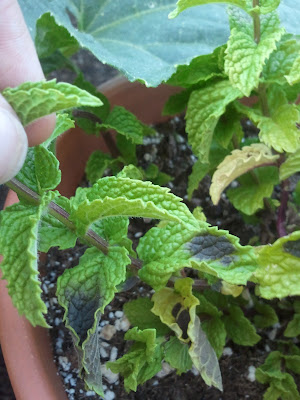 |
| Black mint |
At any rate, it appears that mint sometimes turns black when it has had too much water. It's been very hot, so I've been watering every day, when the soil looked dry. But I'm going to switch to the strategy of waiting until the mint looks like it needs water, and then water it, and see whether that takes care of this little problem.
Wednesday, July 10, 2013
Weed Cleanup, Post-Vacation
I came home from more than a week on vacation, and the weeds around my garden (and a few in the garden) were going a little crazy. I may rethink my garden layout next year - maybe taking a few tips from the Square Foot Gardening method (whose book I just purchased) - and hopefully minimize weeds.
Most of the weeds and cleanup in the picture below are NOT from the garden itself, but from around the garden. My garden is in the back of my yard (I inherited it that way when we bought this house) and there is probably a foot of space between it and the fence behind it. There's also space between it on the fence between our yard and the neighbor's. As a result, weeds sprout up in the cracks, and climb the fence.
I have a theory that the vast amount of foliage is attracting pests that I don't want around. So I did a major cleanup, and plan to think about how I can better manage the out-of-control weeds that are hanging out around my garden. My veggies need their space!
Most of the weeds and cleanup in the picture below are NOT from the garden itself, but from around the garden. My garden is in the back of my yard (I inherited it that way when we bought this house) and there is probably a foot of space between it and the fence behind it. There's also space between it on the fence between our yard and the neighbor's. As a result, weeds sprout up in the cracks, and climb the fence.
I have a theory that the vast amount of foliage is attracting pests that I don't want around. So I did a major cleanup, and plan to think about how I can better manage the out-of-control weeds that are hanging out around my garden. My veggies need their space!
Labels:
weeds
Tuesday, July 9, 2013
Welcome, Butternut Squash!
Butternut squash, welcome to the garden!
I tore out my kale, and I replaced it with a butternut squash transplant, which needs about three months of no frost to grow - to be harvested right before the first frost of the year.
So now was a good time to plant it. I'm very excited about growing butternut squash, but I am nervous about it taking over the garden. From all I read and hear, it would spread out over the entire garden if I let it. My plan is to wait a little, and then try to coax it upward, a la vertical gardening.
This is obviously a first for me to grow butternut squash, but if all works out, it won't be the last!
I tore out my kale, and I replaced it with a butternut squash transplant, which needs about three months of no frost to grow - to be harvested right before the first frost of the year.
So now was a good time to plant it. I'm very excited about growing butternut squash, but I am nervous about it taking over the garden. From all I read and hear, it would spread out over the entire garden if I let it. My plan is to wait a little, and then try to coax it upward, a la vertical gardening.
This is obviously a first for me to grow butternut squash, but if all works out, it won't be the last!
Monday, July 8, 2013
Zucchini Problems? Maybe Not: Small Soft Yellow Fruits and Not So Powdery Mildew
I had no problems at all last year with zucchini, until the end of the summer that is. But even then, I was harvesting large zucchinis.
This year, it appears I will have some good zucchinis with my one plant (vs. my 3 last year), but I'm also seeing some soft, yellow fruits that aren't quite developing. See below:
This might only indicate that pollination isn't happening on these particular fruits. I've taken to just cutting those fruits off, and monitoring the rest of the plant, which is actually producing some healthy looking zucchini plants.
And what I thought was powdery mildew has made an early appearance this year. Or is that what it really was?
This year, it appears I will have some good zucchinis with my one plant (vs. my 3 last year), but I'm also seeing some soft, yellow fruits that aren't quite developing. See below:
 |
| Small soft yellow fruits on zucchini plants. |
This might only indicate that pollination isn't happening on these particular fruits. I've taken to just cutting those fruits off, and monitoring the rest of the plant, which is actually producing some healthy looking zucchini plants.
And what I thought was powdery mildew has made an early appearance this year. Or is that what it really was?
Sunday, July 7, 2013
The Fruits of My Labor: Tomatoes, Cucumbers and Strawberries
All is not lost in my garden. I tend to focus on a lot of problems in my journey toward being a gardener, including the persistent flea beetles and my struggling bell peppers, but I am having some wins.
For example, my Christmas Grape tomatoes are doing as well already as they did last year, in the same location in the garden. Here's the first ripening tomato! I plan to eat it soon!
And my beefsteak tomato is doing better than last year's attempt.
For example, my Christmas Grape tomatoes are doing as well already as they did last year, in the same location in the garden. Here's the first ripening tomato! I plan to eat it soon!
And my beefsteak tomato is doing better than last year's attempt.
Saturday, July 6, 2013
The Flea Beetles Have Moved to My Kale
I think I should have just left the arugula in the ground to attract the flea beetles that subsequently moved to my kale. I came home from vacation to this:
Now, the little buggers were already taking a few bites here and there before I left, but they seem to have multiplied.
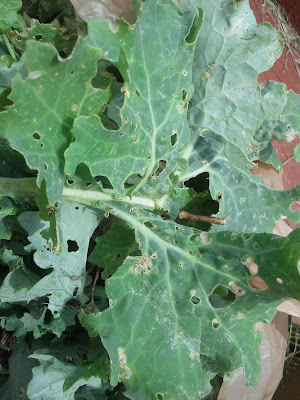 |
| Flea beetle damage on my kale |
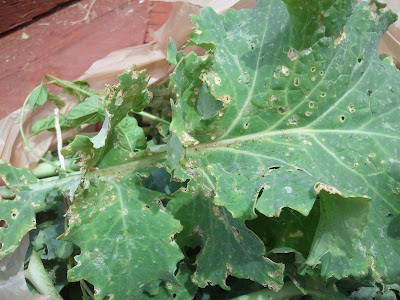 |
| Flea beetle damage on my kale |
Subscribe to:
Comments (Atom)




